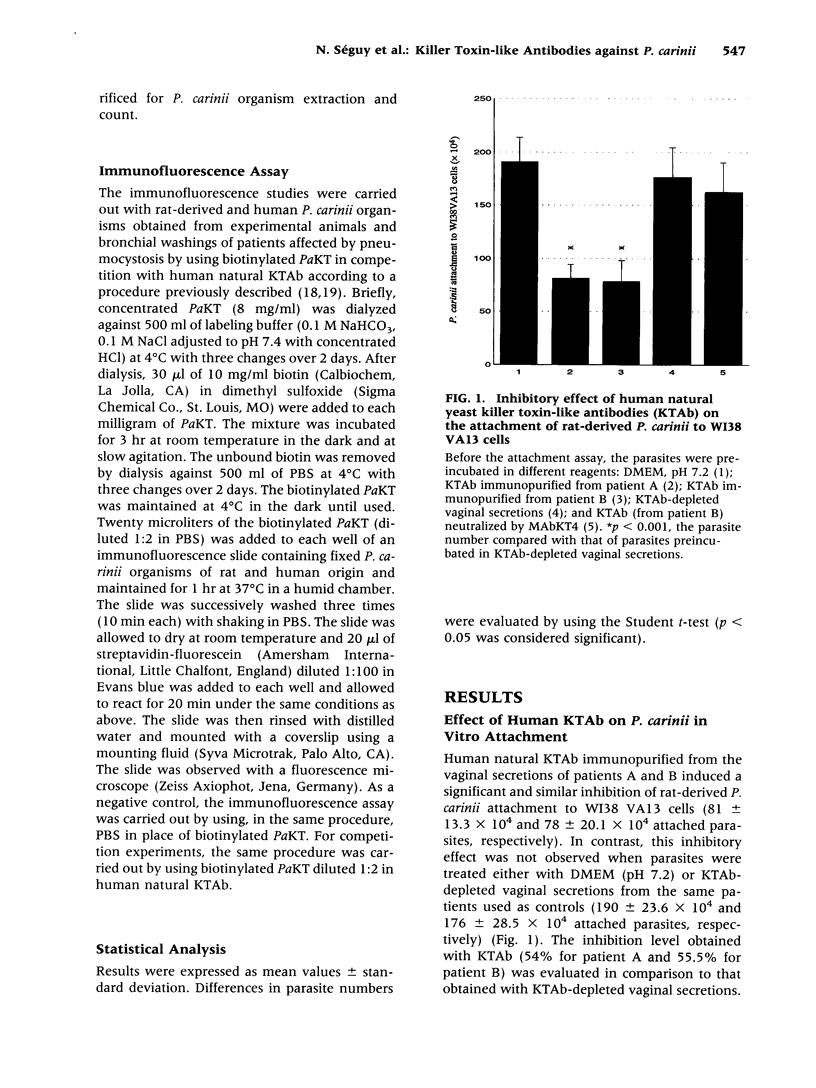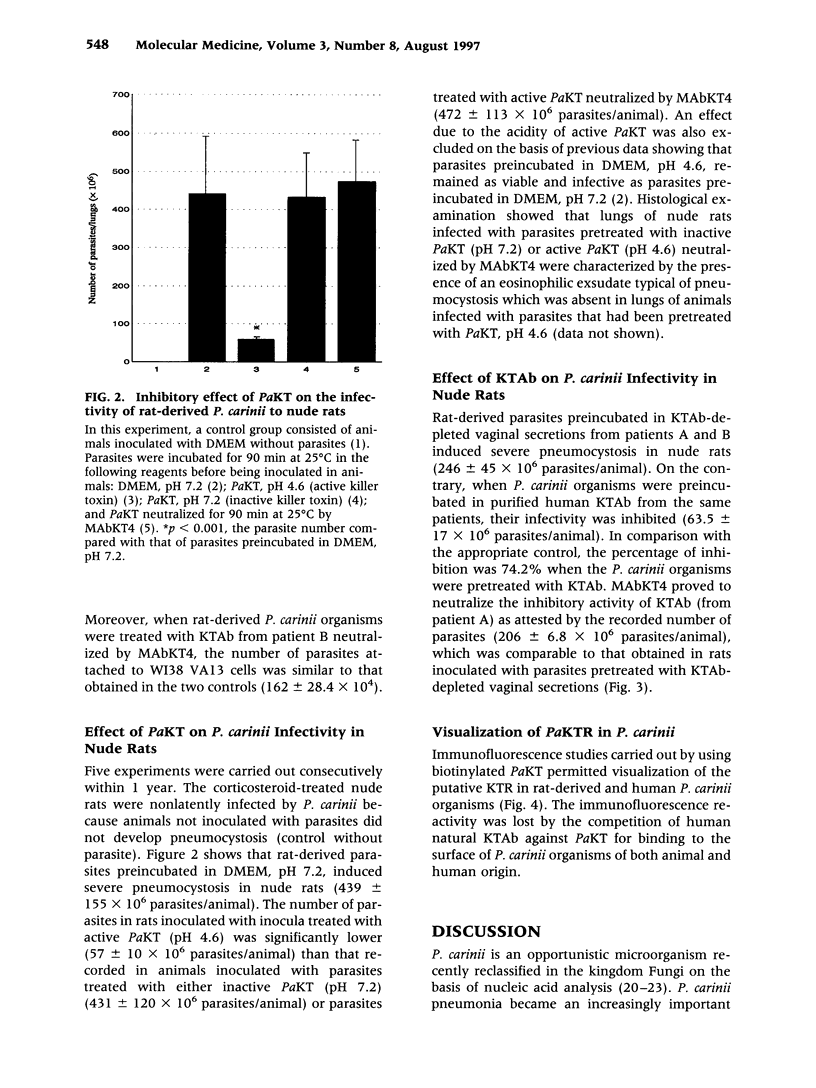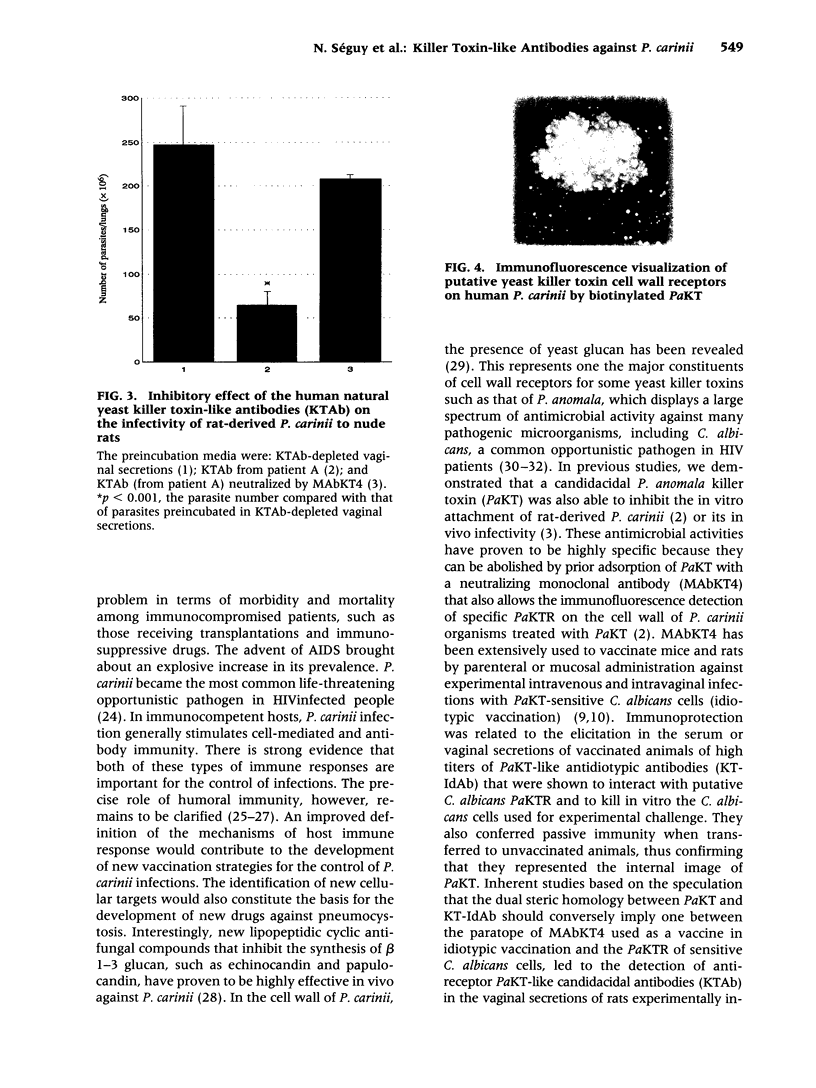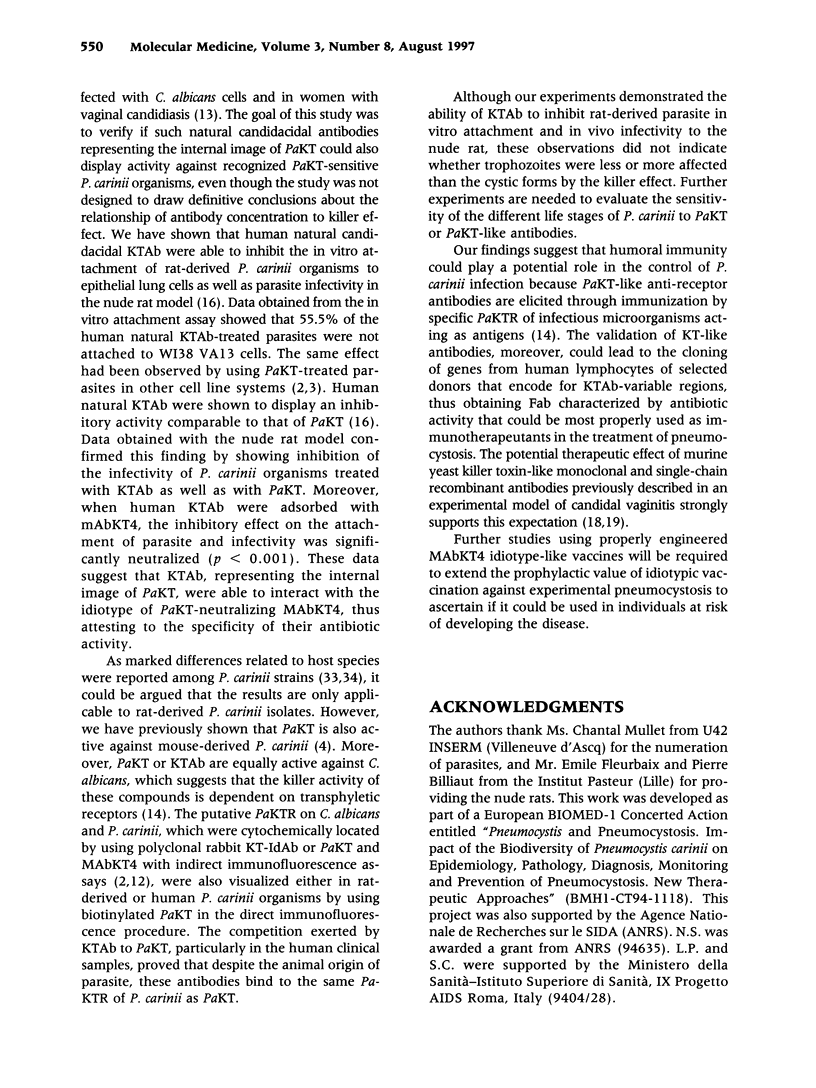Abstract
BACKGROUND: Human natural antibodies have been found that owe their candidacidal action to the mimicry of a yeast killer toxin produced by the yeast Pichia anomala (PaKT). Candidacidal human natural antibodies (KTAb) are elicited by and bind to a KT receptor (PaKTR) present on the cell surface of infectious PaKT-sensitive microorganisms. Because of the recognized susceptibility of Pneumocystis carinii organisms to PaKT upon the occurrence of specific PaKTR, we examined whether human natural KTAb could also bind to and inhibit P. carinii. MATERIALS AND METHODS: Immunoaffinity-purified KTAb from the vaginal fluid of patients affected by candidiasis were tested and compared with PaKT for their ability to inhibit rat-derived P. carinii attachment to epithelial lung cells as well as infectivity to nude rats. Immunofluorescence studies were also performed by biotinylated PaKT in competition with human KTAb to establish their specific binding to PaKTR on the surface of rat-derived and human P. carinii organisms. RESULTS: Human natural candidacidal KTAb exerted a strong, specific inhibitory activity against rat-derived P. carinii organisms that are susceptible to PaKT itself. The antimicrobial activity of human KTAb was abolished by adsorption with a specific PaKT-neutralizing mAb KT4. Immunofluorescence studies of competition with PaKT showed that human KTAb efficiently bind to the specific PaKTR on the surface of rat-derived and human P. carinii organisms. CONCLUSIONS: The results strongly suggest that human KTAb, elicited by a common transphyletic receptor of different pathogenic microorganisms during infection, may play a role in antibody-mediated cross-immunity and, if properly engineered, as functionally equivalent recombinant antibodies they could exert a therapeutic activity against pneumocystosis in vivo.
Full text
PDF








Images in this article
Selected References
These references are in PubMed. This may not be the complete list of references from this article.
- Aliouat E. M., Dei-Cas E., Billaut P., Dujardin L., Camus D. Pneumocystitis carinii organisms from in vitro culture are highly infectious to the nude rat. Parasitol Res. 1995;81(1):82–85. doi: 10.1007/BF00932421. [DOI] [PubMed] [Google Scholar]
- Beck J. M., Liggitt H. D., Brunette E. N., Fuchs H. J., Shellito J. E., Debs R. J. Reduction in intensity of Pneumocystis carinii pneumonia in mice by aerosol administration of gamma interferon. Infect Immun. 1991 Nov;59(11):3859–3862. doi: 10.1128/iai.59.11.3859-3862.1991. [DOI] [PMC free article] [PubMed] [Google Scholar]
- Cailliez J. C., Séguy N., Aliouat E. M., Polonelli L., Camus D., Dei-Cas E. The yeast killer phenomenon: a hypothetical way to control Pneumocystis carinii pneumonia. Med Hypotheses. 1994 Sep;43(3):167–171. doi: 10.1016/0306-9877(94)90147-3. [DOI] [PubMed] [Google Scholar]
- Cailliez J. C., Séguy N., Denis C. M., Aliouat E. M., Mazars E., Polonelli L., Camus D., Dei-Cas E. Pneumocystis carinii: an atypical fungal micro-organism. J Med Vet Mycol. 1996 Jul-Aug;34(4):227–239. doi: 10.1080/02681219680000401. [DOI] [PubMed] [Google Scholar]
- Cassone A., Conti S., De Bernardis F., Polonelli L. Antibodies, killer toxins and antifungal immunoprotection: a lesson from nature? Immunol Today. 1997 Apr;18(4):164–169. doi: 10.1016/s0167-5699(97)84662-2. [DOI] [PubMed] [Google Scholar]
- Kovacs J. A., Halpern J. L., Lundgren B., Swan J. C., Parrillo J. E., Masur H. Monoclonal antibodies to Pneumocystis carinii: identification of specific antigens and characterization of antigenic differences between rat and human isolates. J Infect Dis. 1989 Jan;159(1):60–70. doi: 10.1093/infdis/159.1.60. [DOI] [PubMed] [Google Scholar]
- Magliani W., Conti S., Gerloni M., Bertolotti D., Polonelli L. Yeast killer systems. Clin Microbiol Rev. 1997 Jul;10(3):369–400. doi: 10.1128/cmr.10.3.369. [DOI] [PMC free article] [PubMed] [Google Scholar]
- Magliani W., Conti S., de Bernardis F., Gerloni M., Bertolotti D., Mozzoni P., Cassone A., Polonelli L. Therapeutic potential of antiidiotypic single chain antibodies with yeast killer toxin activity. Nat Biotechnol. 1997 Feb;15(2):155–158. doi: 10.1038/nbt0297-155. [DOI] [PubMed] [Google Scholar]
- Mazars E., Odberg-Ferragut C., Dei-Cas E., Fourmaux M. N., Aliouat E. M., Brun-Pascaud M., Mougeot G., Camus D. Polymorphism of the thymidylate synthase gene of Pneumocystis carinii from different host species. J Eukaryot Microbiol. 1995 Jan-Feb;42(1):26–32. doi: 10.1111/j.1550-7408.1995.tb01536.x. [DOI] [PubMed] [Google Scholar]
- Polonelli L., Conti S., Gerloni M., Magliani W., Chezzi C., Morace G. Interfaces of the yeast killer phenomenon. Crit Rev Microbiol. 1991;18(1):47–87. doi: 10.3109/10408419109113509. [DOI] [PubMed] [Google Scholar]
- Polonelli L., De Bernadis F., Conti S., Boccanera M., Magliani W., Gerloni M., Cantelli C., Cassone A. Human natural yeast killer toxin-like candidacidal antibodies. J Immunol. 1996 Mar 1;156(5):1880–1885. [PubMed] [Google Scholar]
- Polonelli L., De Bernardis F., Conti S., Boccanera M., Gerloni M., Morace G., Magliani W., Chezzi C., Cassone A. Idiotypic intravaginal vaccination to protect against candidal vaginitis by secretory, yeast killer toxin-like anti-idiotypic antibodies. J Immunol. 1994 Mar 15;152(6):3175–3182. [PubMed] [Google Scholar]
- Polonelli L., Fanti F., Conti S., Campani L., Gerloni M., Castagnola M., Morace G., Chezzi C. Detection by immunofluorescent anti-idiotypic antibodies of yeast killer toxin cell wall receptors of Candida albicans. J Immunol Methods. 1990 Sep 14;132(2):205–209. doi: 10.1016/0022-1759(90)90031-p. [DOI] [PubMed] [Google Scholar]
- Polonelli L., Lorenzini R., De Bernardis F., Gerloni M., Conti S., Morace G., Magliani W., Chezzi C. Idiotypic vaccination: immunoprotection mediated by anti-idiotypic antibodies with antibiotic activity. Scand J Immunol. 1993 Jan;37(1):105–110. doi: 10.1111/j.1365-3083.1993.tb01671.x. [DOI] [PubMed] [Google Scholar]
- Polonelli L., Morace G. Production and characterization of yeast killer toxin monoclonal antibodies. J Clin Microbiol. 1987 Feb;25(2):460–462. doi: 10.1128/jcm.25.2.460-462.1987. [DOI] [PMC free article] [PubMed] [Google Scholar]
- Polonelli L., Morace G. Reevaluation of the yeast killer phenomenon. J Clin Microbiol. 1986 Nov;24(5):866–869. doi: 10.1128/jcm.24.5.866-869.1986. [DOI] [PMC free article] [PubMed] [Google Scholar]
- Polonelli L., Morace G. Yeast killer toxin-like anti-idiotypic antibodies. J Clin Microbiol. 1988 Mar;26(3):602–604. doi: 10.1128/jcm.26.3.602-604.1988. [DOI] [PMC free article] [PubMed] [Google Scholar]
- Polonelli L., Séguy N., Conti S., Gerloni M., Bertolotti D., Cantelli C., Magliani W., Cailliez J. C. Monoclonal yeast killer toxin-like candidacidal anti-idiotypic antibodies. Clin Diagn Lab Immunol. 1997 Mar;4(2):142–146. doi: 10.1128/cdli.4.2.142-146.1997. [DOI] [PMC free article] [PubMed] [Google Scholar]
- Sawant A. D., Ahearn D. G. Involvement of a cell wall receptor in the mode of action of an anti-Candida toxin of Pichia anomala. Antimicrob Agents Chemother. 1990 Jul;34(7):1331–1335. doi: 10.1128/aac.34.7.1331. [DOI] [PMC free article] [PubMed] [Google Scholar]
- Schmatz D. M., Romancheck M. A., Pittarelli L. A., Schwartz R. E., Fromtling R. A., Nollstadt K. H., Vanmiddlesworth F. L., Wilson K. E., Turner M. J. Treatment of Pneumocystis carinii pneumonia with 1,3-beta-glucan synthesis inhibitors. Proc Natl Acad Sci U S A. 1990 Aug;87(15):5950–5954. doi: 10.1073/pnas.87.15.5950. [DOI] [PMC free article] [PubMed] [Google Scholar]
- Stringer J. R., Edman J. C., Cushion M. T., Richards F. F., Watanabe J. The fungal nature of Pneumocystis. J Med Vet Mycol. 1992;30 (Suppl 1):271–278. doi: 10.1080/02681219280000961. [DOI] [PMC free article] [PubMed] [Google Scholar]
- Su T. H., Martin W. J., 2nd Pathogenesis and host response in Pneumocystis carinii pneumonia. Annu Rev Med. 1994;45:261–272. doi: 10.1146/annurev.med.45.1.261. [DOI] [PubMed] [Google Scholar]
- Séguy N., Aliouat E. M., Dei-Cas E., Polonelli L., Camus D., Cailliez J. C. Susceptibility of Pneumocystis carinii to a Pichia anomala killer toxin. J Eukaryot Microbiol. 1994 Sep-Oct;41(5):109S–109S. [PubMed] [Google Scholar]
- Séguy N., Cailliez J. C., Polonelli L., Dei-Cas E., Camus D. Inhibitory effect of a Pichia anomala killer toxin on Pneumocystis carinii infectivity to the SCID mouse. Parasitol Res. 1996;82(2):114–116. doi: 10.1007/s004360050080. [DOI] [PubMed] [Google Scholar]
- Séguy N., Polonelli L., Conti S., Dei-Cas E., Camus D., Cailliez J. C. In vitro decrease of rat-derived Pneumocystis carinii attachment induced by human natural yeast killer toxin-like antiidiotypic candidacidal antibodies. J Eukaryot Microbiol. 1996 Sep-Oct;43(5):27S–27S. doi: 10.1111/j.1550-7408.1996.tb04964.x. [DOI] [PubMed] [Google Scholar]
- Wakefield A. E., Peters S. E., Banerji S., Bridge P. D., Hall G. S., Hawksworth D. L., Guiver L. A., Allen A. G., Hopkin J. M. Pneumocystis carinii shows DNA homology with the ustomycetous red yeast fungi. Mol Microbiol. 1992 Jul;6(14):1903–1911. doi: 10.1111/j.1365-2958.1992.tb01363.x. [DOI] [PubMed] [Google Scholar]
- Walzer P. D. Pneumocystis carinii--new clinical spectrum? N Engl J Med. 1991 Jan 24;324(4):263–265. doi: 10.1056/NEJM199101243240411. [DOI] [PubMed] [Google Scholar]






